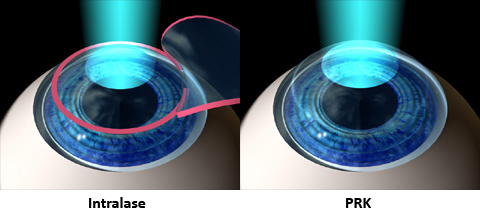 When it comes to laser vision correction, there are 2 different procedures that we offer, Intralase and Photo Refractive Keratectomy (PRK). There are some slight differences between the two procedures, one of which will work best for your eyes.
When it comes to laser vision correction, there are 2 different procedures that we offer, Intralase and Photo Refractive Keratectomy (PRK). There are some slight differences between the two procedures, one of which will work best for your eyes.
The ultimate difference between Intralase and PRK lies in what is done with the surface of the cornea before the laser treatment is applied. With Intralase, also called iLASIK, a corneal flap is created and the Excimer laser applies the custom treatment to the inner tissue of the cornea. With PRK, the epithelium (or outer skin of the cornea) is removed and the Excimer laser applies the custom treatment to the surface of the cornea.
Intralase
 Until now, the flap has been created with a mechanical, bladed device called a microkeratome. With the bladed style microkeratome there was an increased risk of complications such as corneal abrasions, irregular flaps, as well as button-hole flaps. Bladeless LASIK offers our patients increased safety by eliminating the blade.
Until now, the flap has been created with a mechanical, bladed device called a microkeratome. With the bladed style microkeratome there was an increased risk of complications such as corneal abrasions, irregular flaps, as well as button-hole flaps. Bladeless LASIK offers our patients increased safety by eliminating the blade.
Bladeless LASIK offers the ability to create a flap of uniform thickness at a preprogrammed depth. The traditional style microkeratome did not account for the curvature of the cornea and created a meniscus style flap, with the edges somewhat thicker than the center. Any variation in flap thickness will result in a variation of your visual outcome. Because we know exactly what depth the flap is being created, we are able to preserve the most corneal tissue following the procedure, leaving each patient with a stronger, more stable eye.
The corneal flap is created in an “inside out” process. The laser beam creates a dissection plane by forming an interconnecting series of bubbles (made of carbon dioxide and water vapor). The Intralase laser beam stacks a pattern of bubbles along the periphery of the ablation plane, leaving an uncut section of tissue.
After the corneal flap is created, the information previously gathered to fit the unique characteristics of the individuals’ eyes is then translated into a set of CustomVue treatment instructions for the laser.
PRK
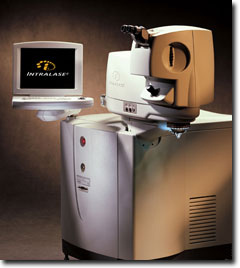 Photo Refractive Keratectomy (PRK) was the first procedure performed using the Excimer laser. With PRK a corneal flap is not created, instead the cornea’s epithelial (outer) layer is removed. After the outer layer is removed, the computer-controlled, highly specialized Excimer laser delivers pulses of cool ultraviolet light that then sculpts the stromal layer of the cornea to correct your refractive error. PRK can be used to correct low to high levels of nearsightedness, farsightedness and astigmatism through reshaping the cornea.
Photo Refractive Keratectomy (PRK) was the first procedure performed using the Excimer laser. With PRK a corneal flap is not created, instead the cornea’s epithelial (outer) layer is removed. After the outer layer is removed, the computer-controlled, highly specialized Excimer laser delivers pulses of cool ultraviolet light that then sculpts the stromal layer of the cornea to correct your refractive error. PRK can be used to correct low to high levels of nearsightedness, farsightedness and astigmatism through reshaping the cornea.
To treat nearsightedness: the steep cornea is made flatter by removing tissue from the center of the cornea. This moves the point of focus from in front of the retina to directly on the retina.
To treat farsightedness: the flat cornea is made steeper by removing tissue outside of the central optical zone of the cornea. This moves the point of focus from behind the retina to directly on the retina.
To treat astigmatism: the cornea is made more spherical — like a basketball instead of a football. This eliminates multiple focusing points within the eye and creates one point of focus on the retina. Astigmatism can be treated at the same time as nearsightedness and farsightedness.
PRK is for Those Who:
- Are over 21 years of age
- Have had a stable eye prescription for at least one year
- Have no health issues affecting their eyes
- Have corneas too thin for LASIK
- Have large pupils
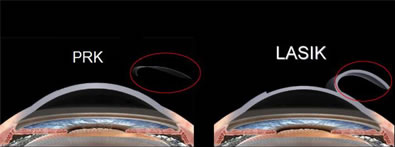
Is LASIK laser eye surgery right for you?
The best way to find out is to contact us. One of our LASIK coordinators will get in touch to discuss your options. You can also learn about financing that is available.
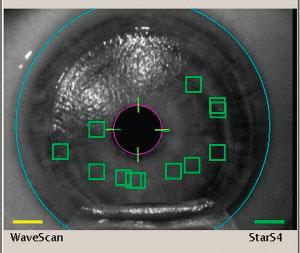 In order to achieve optimized outcomes for laser vision correction patients, accurate alignment is essential to optimizing customized Wavefront-guided procedures. The VISX™ Iris Registration Technology is a revolutionary method of aligning the treatment to the cornea and providing the most precise laser alignment accuracy to date. Previously, physicians used manual methods to align the treatment to the eye.
In order to achieve optimized outcomes for laser vision correction patients, accurate alignment is essential to optimizing customized Wavefront-guided procedures. The VISX™ Iris Registration Technology is a revolutionary method of aligning the treatment to the cornea and providing the most precise laser alignment accuracy to date. Previously, physicians used manual methods to align the treatment to the eye.



 When it comes to laser vision correction, there are 2 different procedures that we offer, Intralase and Photo Refractive Keratectomy (PRK). There are some slight differences between the two procedures, one of which will work best for your eyes.
When it comes to laser vision correction, there are 2 different procedures that we offer, Intralase and Photo Refractive Keratectomy (PRK). There are some slight differences between the two procedures, one of which will work best for your eyes. Until now, the flap has been created with a mechanical, bladed device called a microkeratome. With the bladed style microkeratome there was an increased risk of complications such as corneal abrasions, irregular flaps, as well as button-hole flaps. Bladeless LASIK offers our patients increased safety by eliminating the blade.
Until now, the flap has been created with a mechanical, bladed device called a microkeratome. With the bladed style microkeratome there was an increased risk of complications such as corneal abrasions, irregular flaps, as well as button-hole flaps. Bladeless LASIK offers our patients increased safety by eliminating the blade. Photo Refractive Keratectomy (PRK) was the first procedure performed using the Excimer laser. With PRK a corneal flap is not created, instead the cornea’s epithelial (outer) layer is removed. After the outer layer is removed, the computer-controlled, highly specialized Excimer laser delivers pulses of cool ultraviolet light that then sculpts the stromal layer of the cornea to correct your refractive error. PRK can be used to correct low to high levels of nearsightedness, farsightedness and astigmatism through reshaping the cornea.
Photo Refractive Keratectomy (PRK) was the first procedure performed using the Excimer laser. With PRK a corneal flap is not created, instead the cornea’s epithelial (outer) layer is removed. After the outer layer is removed, the computer-controlled, highly specialized Excimer laser delivers pulses of cool ultraviolet light that then sculpts the stromal layer of the cornea to correct your refractive error. PRK can be used to correct low to high levels of nearsightedness, farsightedness and astigmatism through reshaping the cornea.
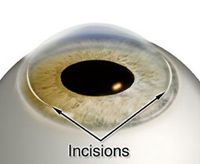 The outer layer of the eye can be divided into three areas: the cornea, the sclera and the limbus. The cornea is the clear part, or the window, that covers the iris and the pupil. The sclera is the white part of the eye. The limbus is the thin area that connects the cornea and the sclera.
The outer layer of the eye can be divided into three areas: the cornea, the sclera and the limbus. The cornea is the clear part, or the window, that covers the iris and the pupil. The sclera is the white part of the eye. The limbus is the thin area that connects the cornea and the sclera.